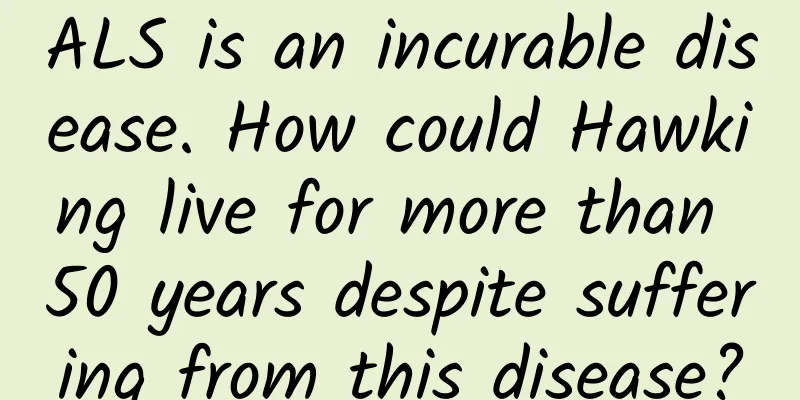ALS is an incurable disease. How could Hawking live for more than 50 years despite suffering from this disease?

|
The scientific name of ALS is "amyotrophic lateral sclerosis syndrome", which is listed as the first of the five incurable diseases in humans by the World Health Organization. my country's "First List of Rare Diseases" includes 121 diseases, and ALS is listed as the fourth. The cause of ALS is still unknown. Research suggests that about 20% of cases may be related to heredity or gene defects, and the rest are caused by environmental factors, such as heavy metal poisoning, which causes damage to motor neurons. The main symptoms of this disease are: initially, they only feel weak, twitching, and fatigue, and gradually progress to muscle atrophy, difficulty swallowing, and respiratory failure. Death from ALS is usually caused by complications, such as bedsores and lung infections caused by paralysis, which eventually lead to death from respiratory paralysis and suffocation. So far, there is no specific drug for this disease in the world. The treatment is generally supportive therapy, which is to treat the symptoms, but it cannot reverse the process of muscle atrophy, and there is no precedent for cure. After being diagnosed with this disease, the average survival period of patients is about 5 years, some can live for two or three years, and some can live for decades. There is no absolute death date, nor is there a strict statistic that the mortality rate is 90% within 5 years. Even if there is, then Hawking should be in the 10% range. Therefore, Hawking is a miracle. Hawking was diagnosed with ALS at the age of 21, and he has been fighting the disease ever since, tenaciously living in a wheelchair for more than 50 years until he died in 2018 at the age of 76, creating a brilliant miracle for a disabled person. In a wheelchair, Hawking could only move his eyes and three fingers. However, with his fearless optimism, he wrote papers and books, gave speeches, and even participated in various scientific activities around the world with the help of high-tech intelligent machines. He also went to an altitude of 10,000 meters to experience weightlessness. Hawking has been to China three times. In 1985, he first came to China, visited Beijing Normal University and China University of Science and Technology, and gave academic lectures on astrophysics. In 2002, Hawking came to China for the second time, giving popular science lectures on the theme of "Brane New World" in Beijing and Hangzhou. On the morning of June 19, 2006, Hawking explained "The Origin of the Universe" to the public in Beijing at the Great Hall of the People. He has also visited Japan and the United States many times to participate in various academic activities and speeches. Hawking has also participated in the filming of many movies and documentaries, such as playing himself in "Star Trek: The Next Generation" and playing bridge with Newton and Einstein. He has created world-leading theories in astrophysics, especially in black hole research, and has won many of the world's top scientific awards. In addition to his academic achievements, his contribution to popular science is even greater. He has written many popular science books, such as "A Brief History of Time" and "The Universe in a Nutshell", and has gained countless fans around the world. He also opened his own account on Sina Weibo, gained millions of Chinese fans, and patiently answered fans' questions. It is very rare that Hawking could live so long after suffering from ALS. It is generally believed that the main reason is that Hawking's disease has its own special development, which did not seriously affect his respiratory and swallowing muscles. He can breathe normally and eat without dehydration and malnutrition. In addition, his optimistic spirit and the support of high technology for his exchange of ideas also played an important role. But the most crucial thing is that the disease develops in different directions, which is the most important reason. The Cyborg Journey of an ALS Patient Although ALS is a rare disease, its incidence is far beyond the expectation of "rare". According to statistics, there are more than 520,000 ALS patients in the world, and there are as many as 60,000 in my country. Some statistics even believe that there are 200,000 ALS patients. These patients are struggling on the line between life and death, and most of them will die within 5 years. Another famous ALS patient in the world is Peter Scott Morgan, a British robotics scientist. In 2017, the 59-year-old Morgan was diagnosed with ALS and the doctor told him that he only had 6 months to live. As a robotics expert, Peter decided to transform himself into a human-machine combination to gain a longer lifespan. At the same time, through his own experiments, he has opened up a new path for similar diseases to save the world's millions of paralyzed patients. Peter wrote in his book Robot Revolution published in 1984: "If humans choose to embark on the path of 'enhanced humans'... humans will one day be able to replace overly fragile bodies with more permanent machines." Therefore, he regarded his incurable disease as an opportunity given to him by God, and asked the medical team to transform him into the first "cyborg" in human history. The so-called "cyborg" is the transliteration of the English word Cyborg, also known as electronic man, robot, modified man, biochemical man, etc. It is the combination of the inorganic matter of the machine and the organic body of the human body, and the human body's ability is increased and strengthened through artificial technology and artificial intelligence. Peter asked for some machines with artificial intelligence to replace his gradually lost speaking, breathing and swallowing functions. So, in 2018, Peter took a crucial step. The medical team surgically connected three tubes to him: one in the stomach to deliver nutrients, one to the bladder to drain urine, and one to the colon to handle excrement. Morgan calls these operations "triple ostomies." After that, Peter's condition deteriorated rapidly, and his larynx was cut off, which made him lose his ability to speak. His body became just a shell, but his brain remained awake. A series of high-tech support was used to try to solve Peter's communication problem, including the participation of scientists who designed the high-tech configuration of Hawking's wheelchair, and some of the scientific research results of Hawking's wheelchair were used for reference. As a result, Morgan finally became an immobile "cyborg". In October 2019, Peter tweeted: This is my last post as Peter 1.0. I am about to become Peter 2.0, the world's first complete cyborg. After the operation, Peter declared: I have died as Peter 1.0, and now I am reborn as Peter 2.0. In 2020, the documentary "Peter: The Human Cyborg" was broadcast. In the film, the virtual image of Peter 2.0 was realized with the help of AI technology. It has natural expressions and an emotional voice. It can laugh, smile, and blink. It can also make Peter's signature action before he got sick - raising his right eyebrow when excited. Peter 2.0 works 60 hours a week, attends various speeches, and accepts interviews. In 2021, Peter 2.0 claimed in an interview that the next goal is to challenge "free movement", with the goal of achieving automatic driving, quickly passing obstacles, safely shuttling through porcelain shops, and boldly going to places that wheelchairs cannot go. Everything seemed fine, but he was not as lucky as Hawking. In April this year, his condition deteriorated sharply. He tweeted that he could not close his eyes and could no longer communicate with others using eye tracking. He wanted to try to use a brain-computer interface to transfer his consciousness, but the technology was not mature. Intel's brain-computer experts did not make a miracle happen after they came to his house. Peter passed away on June 15. Peter survived for four and a half years after being diagnosed with this terrible disease, and did not break the five-year survival curse, but he broke the six-month and two-year deadlines given by the doctor, which shows that his "cyborg" efforts were not in vain and that modern technology played a role, otherwise he would probably have died of complications long ago. But it also shows that modern technology is still far from being able to achieve true "cyborgs" and cannot truly resist various difficult diseases. But Peter's attempt is meaningful and provides a useful reference for humans to transform themselves into stronger ones. With the improvement of scientific and technological levels, if brain-computer interfaces or consciousness uploading can really succeed, it will be a big leap in human evolution. There is another famous case whose survival period has exceeded 5 years. He is Zhang Dingyu, the director of Wuhan Jinyintan Hospital. He was diagnosed with ALS in 2017, but he kept silent and insisted on going to work. When the COVID-19 outbreak occurred in Wuhan, his disease had been developing for two years. His calves had atrophied and he walked with a limp, but he dragged his sick body to command calmly and take the lead, insisting on being on the front line. Later, he was awarded the title of "People's Hero" by the state. It has been five years since his ALS attack. Although he is no longer the director of Jinyintan Hospital and has been transferred to the deputy director of the Hubei Provincial Health Commission, he is still working. According to some reports, after treatment, his condition has been effectively controlled, the muscle fiber atrophy of the lower limbs has improved to a certain extent, and the state of his right leg being thinner than the left leg has been restored. He can now ride a bicycle to go out. I think it's not that there is a special medicine that cured his disease, but that everyone's condition and development are different. Zhang Dingyu is luckier, his condition is milder, it develops more slowly, and symptomatic treatment has alleviated it to a certain extent. If there really is some special treatment, the country would have announced it long ago, and the World Health Organization would have removed this disease from the list of terminal illnesses. It is said that there are 200,000 ALS patients in my country struggling on the line between life and death. If there were good treatments, how could Zhang Dingyu, the "people's hero", keep it to himself? As a doctor and a leader of the medical and health department, he would have promoted it vigorously long ago. Therefore, ALS is still a major incurable disease in the world, but the cause is very complicated, and each person's condition and development are different, and the survival period is also different. Hawking is very lucky that his disease did not damage his respiratory and swallowing systems. Coupled with Hawking's optimism and high-tech support, he has become the longest-lived ALS patient in the world. Hawking made outstanding contributions throughout his life to mankind's ability to understand the world more deeply. This is not only Hawking's fortune, but also mankind's fortune. That’s all for today. Welcome to discuss and thank you for reading. This work is originally copyrighted by Spacetime Communication. Please respect the originality and do not infringe upon or plagiarize. Thank you. |
<<: Which is more harmful: eating midnight snacks or staying up late and being hungry?
Recommend
A 52-year-old woman has suffered three fractures in three years. What is the reason? What should you do in winter to be a "hard bone"
My classmate's aunt is 52 years old, looks ve...
Traffic is so expensive, but conversion rate is so low?
Traffic is so expensive and conversion is so low!...
China Automobile Dealers Association: Analysis of China's imported automobile market in April 2022
(I) Supply: After three years of decline, automob...
Sharp's return to China lets Xiaomi MIX know what black technology is
August 8, 2017 is a magical day. On this day, VAI...
Reviewing the “screen dominating” marketing of vivo’s full-screen mobile phones: How do you spend your money?
On October 8, Lu Han announced his relationship w...
The photos taken by the Hubble telescope are actually black and white, but NASA used PS to turn them into color...
In the Cat's Eye Nebula three thousand light-...
How to write a new media marketing promotion plan!
What role does new media marketing play? How to s...
This flower gives scientists a headache! It can also transform into 72 different forms!
"Seventy-two Transformations" is one of...
Families, enjoy drinking lemonade in the summer!
As the beginning of autumn arrives, many people i...
What's special about Microsoft Edge browser?
When Windows 10 arrives, the default browser will...
Chinese and Japanese tea culture: Both find the other side incredible
Chinese and Japanese tea culture: Both find the o...
ZCOOL Master Hou Shuai's E-commerce Design All-Round Class
ZCOOL Master Hou Shuai's E-commerce Design Al...
Mobile games are moving towards the era of "alliances"丨The 5th Global Mobile Games Conference will be held in March
With the rapid popularization of smart phones and ...
An activity operation plan that can attract thousands of fans!
Article introduction: This article mainly introdu...
Advertising landing page optimization rules!
We all know that the key to a landing page is tha...









